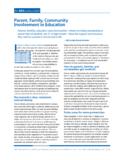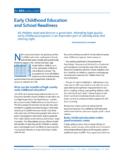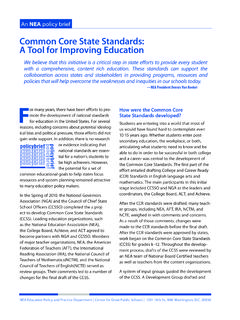Transcription of External Partnerships and Advocacy 1201 Sixteenth Street ...
1 External Partnerships and Advocacy1201 Sixteenth Street , NWWashington, 20036 Guide to Teaching Online Courses is the product ofcollaboration among a number of organizations committed toensuring the quality of online instruction to secondary students inthe United States. It is intended as a guide for policymakers,administrators, educators, and others engaged in selecting,hiring, training, and supporting teachers to provide qualityonline instruction to students, or in making policy choicesaffecting online education. It is designed to provide an overviewof the development of an effective online education system,focusing particularly on the skills teachers need to teacheffectively online, the professional development necessary toacquire those skills, and the models schools need to evaluateand improve online teaching.
2 It is critically important that schoolsystems and school administrators contemplate such issuesbefore launching online courses or enrolling significant numbersof their students in such courses. Crucial lessons from decades ofoffline instruction are applicable, and the body of new andinstructive information about the unique nature of onlineeducation is growing every day. An earlier publication, Guide to Online High School Courses, setforth criteria for quality online courses, seeking to empowerstudents, parents, educators, administrators, and policymakersto assess the quality of online courses and to help them establishquality standards for courses of their own design. By contrast,this publication is focused on ensuring that the teachers leadingonline courses are of the highest quality, well equipped, trained,and supported for the many challenges of educating today sstudents via online instructional organizations collaborating in the creation of this guide arelisted below:International Society for Technology in Education (ISTE)National Education AssociationNorth American Council for Online LearningNational Commission for Teaching and America s FutureVirtual High School, IOverview of Online Education: Opportunities and Challenges for Students and for for Students.
3 1 Opportunities for the Profession ..2 Realities and Caveats ..3 SECTION IIDeveloping an Effective Online Education 5 Defining an Effective Online Education Environment .. 5 Aligning the System with Core Beliefs on Effective Online Education ..6 Creating an Effective System for Online Learning and Teaching ..7 SECTION IIIP reparing and Supporting Online 9 Defining Credentials and Skills of Highly Qualified Online Teachers .. 9 Defining and Implementing Effective Professional Development for Online Teachers ..10 Evaluation and Assessment of Online Teaching ..12 Preparing the Next Generation of Online Teachers: Preservice Education ..12 SECTION IVSkills of Online 15 SECTION VFuture Considerations and Next 21 Role of Statewide, Regional, and National Accrediting Agencies ..21 Considerations for Local, State, and National Policymakers ..21G u i d e t o T e a c h i n g O n l i n e C o u r s e sOpportunities for StudentsThe rise of personal computing and the Internethas changed modern life in ways large and home, work, and school, the world is adifferent and smaller place, with information atpeople s fingertips in ways that would haveseemed unimaginable as little as a generationago.
4 Where once the average American school sroster of on-site high technology was an A/V Closet filled with filmstripprojectors and slide carousels, schools today are equipped with computers,internet access handhelds, and other high tech tools for students, teachers,and to these technological breakthroughs, American schools have newclassroom models available to them. The ubiquity of computers in schools(virtually all of the nation s public schools today have computers withInternet access, according to NCES1) has opened the door to a new set ofeducational possibilities: online courses now make it possible for students ineven the most remote locations to have access to classes their homeschools were previously unable to provide. The lesson of large-scale naturaldisasters such as Hurricane Katrina is that the provision of educationalservices to students need no longer be constrained within classroom good courses require good teachers.
5 This is where the onlineopportunity provides the greatest opportunity, and the greatest teaching shares much with face to face teaching, but it also has aunique set of skills and requirements if educators are to teach well are only beginning to consider the possibilities of codifying andassessing standards for online teaching, like those suggested in this guide,through programs that acknowledge proficiency. Unless standards forteaching online are defined, and taken seriously, we will miss theopportunity to ensure that high standards are met and maintained equallyacross the nation. Just as every student deserves a highly qualified teacherin a bricks and mortar classroom, every student deserves a highly qualifiedteacher of Online Education: Opportunities and Challenges for Students and for Department of Education, National Center for Education Statistics. (2003).Internet Access in Public Schools and Classrooms: 1994-2002(NCES 2004-011).
6 Section I1G u i d e t o T e a c h i n g O n l i n e C o u r s e sOpportunities for theProfessionOnline teaching can be a boon for teachersthemselves, making it possible for educators, liketheir students, to have access to the professionalresources they need to continue to learn. If onlineprofessional development is taken seriously anddone right, every teacher, novice andexperienced, could have the opportunity to learn from the best. They can beprepared in situations where they can observe master teachers, working witheffective strategies in the most challenging of circumstances, and indiscussions with those master teachers, reflect on what works or does notwork. Online courses also provide a powerful way to enhance teachers opportunities for quality professional development. Some teachers will takeonline courses or modules to fill in the gaps in their certification requirements;others to address key topics for their continuing growth.
7 For example,working with its 16 partner states, the Southern Regional Education Boardcooperative enlisted state department staff in developing a series of onlinecourses, open to teachers from across the region, including Using Data toClose Achievement Gaps (KY); West Virginia Writing Assessment -WritingAcross the Curriculum (WV); Using Technology for Effective ClassroomAssessment (MD); Data-Based School Reform (VA); Inquiry in the ScienceClassroom: Using Internet-Based Data Sources (GA); Transforming theClassroom with Project-Based Learning (SC and TN).Online networks can also help support novice teachers, during the stressfulearly years of teaching, in online learning communities that link them withpeers and additional mentoring support beyond those found in theirhome schools. Teachers can also link with other teachers informally throughsuch resources as Tapped In s multi-user virtual environment for professionaldevelopment ( ).
8 Beyond the extra resources available online for teachers, online teaching canprovide another important element of teacher learning: it makes the processof teaching public and extends it beyond the school walls. Teaching need nolonger be conducted behind the closed door of the classroom. In onlinecourses, the curriculum, the teacher s daily lesson plans, the interaction in theclassroom, are all on display, available for capture and replication. Privacyrequirements guarantee that student privacy be protected, but, becauseteachers are rightly accountable, the work of an online teacher is visible inways unseen before the medium was developed. This visibility can be usedto build reflective communities of practice within schools and across , and perhaps most positively, online teaching provides ways forteachers to expand their professional roles without leaving the who have not had consistent access to quality professionaldevelopment to develop new skills can now learn best practices addition, teachers can teach to their passions, rather than leaving teachingfor administrative positions or new challenges outside the field.
9 The historyteacher with a special expertise in the Civil War can teach a module,semester, or year long course to a class of students with backgrounds2G u i d e t o T e a c h i n g O n l i n e C o u r s e sstretching from the deep South to New England. A math teacher with specialsuccess in teaching Algebra to students with math difficulties can share thatteaching skill with students beyond her home school. A German teacher canoffer an AP German class even if no students in his school are interested intaking German that year. Experienced master teachers can extend theirprofessional options by serving as online mentors to colleagues and newteachers, even if their local schools have no positions that call upon their usingthese talents. In short, online teaching can extend the boundaries of theprofession, making it more flexible, more creative, and, in a word, and CaveatsThese opportunities come with a sense of are preparing teachers for a new generation oflearners who grew up with computer and Internettechnology millennial learners who use technologyin all aspects of their lives, but who still see littlesignificant use of technology to extend theirclassroom learning.
10 A recent study by the Bell SouthFoundation confirms this reality. When students and their teachers were askedabout technology use in the classrooms, their perceptions were vastly different,and this disparity grew significantly between 2000 and 2002. As the reportstated, The widening gap between the perceptions of what teachers andstudents believe is or is not happening in the classroom is a startling red Even more significantly, while young people going into teaching today arethemselves members of the millennial generation, their teacher preparationprograms rarely include courses either about online teaching, or conductedthrough distance learning. Both traditional and alternative programs forpreparing new teachers are missing an important component of preparingnew teachers for millennial teaching. Without modeling of effective onlineteaching, most of the 86,000 new teachers who enter the profession eachyear begin without online teaching skills in their professional repertoire.










